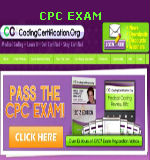I will give you an example, I was taking an exam. Now mind you, for occupational therapy, we had to do anatomy and I had to cut up cadavers. I had to know. My teacher put a pin in it and says what muscle is that on that cadaver. That’s how detailed it was. I have taught medical terminology so I am taking the course; I got stumped on the Medical Terminology question. I was so mad. You know, as type A, “What? What is that? I have never heard that word! They are making up things?”
CPC Exam Using Your Manual – Video

I was just bound and determined. I was not going to miss a Medical Terminology question. When I came back to it later, I thought “Okay, I teach my students to be resourceful, how could I do it? Oh I know.” I looked it up in the index, the root word, and it came to be some obscure bone in the foot that I had forgotten about. But because it took me to bone removal in the foot, I was like “Oh!” I was able to figure out the answer.
Did I know it right off the bat? No. Through process of elimination, could I figure it out? No. But I used the index. You could maybe use that to help you, either the CPT or the ICD index. Probably with anatomy, I’d start with CPT.
Another case in point, I remember a question about valves of the heart, and was asked which valve goes from this chamber to that chamber. I didn’t remember and I got it wrong. But I remembered when I went home I wanted to look it up. I was like, “Oh my God, there is a picture of the heart in the front of CPT that showed me exactly what two chambers that was between.” It is about knowing what you have, and becoming one with your manuals and knowing where the stuff is.
I really recommend to just flip through almost every page and just… You might not know exactly where it is, but you will know it is there.
![[CCO] Certification Coaching Organization LLC [CCO] Certification Coaching Organization LLC](https://www.cco.us/wp-content/uploads/2015/05/CCO-Logo-2015-d3-500px.png)
